Rome Post Script -- these are
the photographic adventures on our three extra days in Rome. We
revisited some places we had been and went to some new places.
Day One visits:
St. John Lateran;
Basilica di S.
Clementi; The
Colosseum, The Roman Forum
Day Two; St. Peter's,
S. Ignazio,
Piazza della
Porta Maggiore, S. Croce in
Gerusalumme, S. Prassede
Day Three: Piazza del Populo, Cerasi
Chapel, S. Maria del Popolo, Capitoline
Hill, Senators'
Palace, Basilica Di
S. Pudenziana
JT### always refers to a page citation to Judith Testa's
very informative book, "Rome
is Love Spelled Backward".
| The Papal coronation actually takes place
here at St.
John Lateran. It is the Rome
Cathedral and the home of the Bishop of Rome. It
was a quick three-stop metro ride for us, but
involves an elaborate procession from the Vatican
for a new Pope. JT91. |
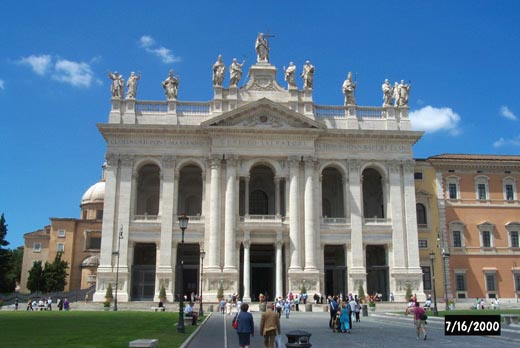 |
 |
| Here and St. Peter's were the only churches
where our tripod was ruled out of place. I had to
find a ledge in the back to get the bean-bag
interior above. These were tricky to do since it
was necessary to eliminate moving persons in the
foreground. Note the stone statues lining the
interior. One of them had a face-like image on it
and it resembled a similar mask we saw on a
statue in St. Peter's. |
|
| I believe this is part of the ceiling. |
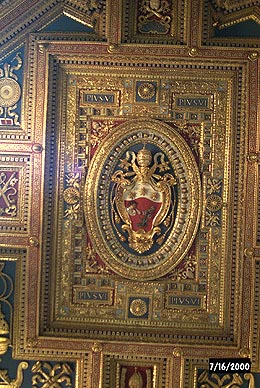 |
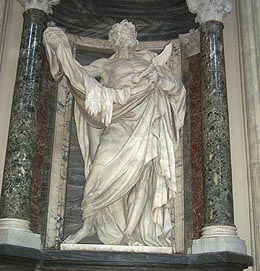 |
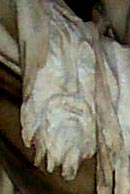 The guide
there explained that this was like an autograph
since it was a resemblance of the sculptor.
Could this be the same here? The guide
there explained that this was like an autograph
since it was a resemblance of the sculptor.
Could this be the same here? |
|
After visiting St. John Lateran, we
walked up Giovanni in Laterano toward the Colosseum, but
we decided first to visit Basilica di S.
Clementi. It was hard to
find since its exterior in totally unspectacular. But
inside, we were rewarded with a spectacular experience.
The top layer shown below is a medieval church built in
the early 1100's, but after paying a small fee, one can
tour the lower levels. |
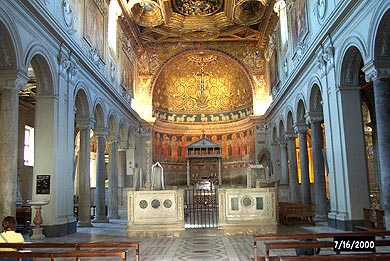 |
| The beautiful interior of the
top level of the Basilica. Below is an
enlargement of the unusual "living
cross" from which grows a vine symbolizing
the redemptive power of Christ. The center photo
is the ceiling fresco of S. Clemente. |
|
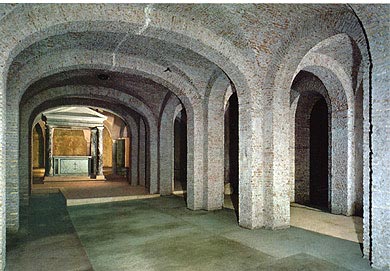 |
| The second layer,seen above, was
only discovered in 1857 when Fr. Joseph Mullooly,
the abbot of S. Clemente, determined from the
architectural style that another older church
must be below. This one dated back to the fourth
century. |
|
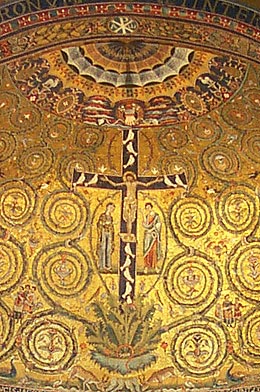 |
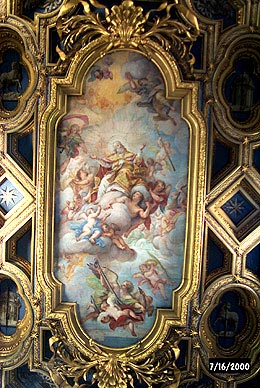 |
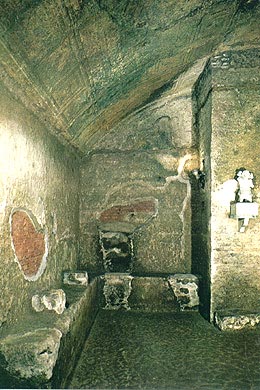 |
| But the picture to the far
right and below depicts the astonishing third layer of S.
Clemente which dates back to the first century, A.D.
walking through this space is simply fantastic. It
clearly represented the level of Rome at the time of
Clemente. These are the Mithraic rooms which are part of
the Roman house of Titus Flavius Clemens. It burned to
the ground in 64 A.C. in the fire that Nero tried to
blame on the Christians. You can hear and see water
rushing in the lower level, either from a spring or the
remains of an ancient aqueduct. There is so much more to
this exciting and rarely visited place not discussed here
but fully described in JT 109-117. |
| We continued walking West on S. Giovanni
in Laterno and came to the famous Colosseum,
perhaps the most famous view in the city. |
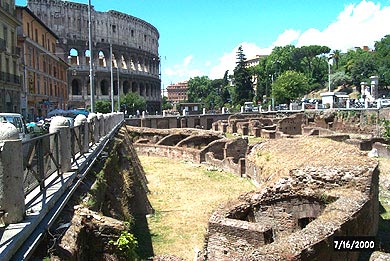 |
| This ruin-type landscape was
here in 1992 as well. |
|
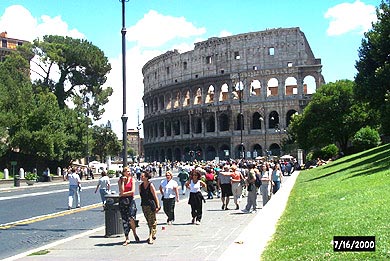 |
| These were the only two photos
we took this time. |
|
|
|
| We took these two pictures in
1992 when we toured Rome last. I'm not sure if
they are brown from age or if there was a serious
drought in that year. We took the tour of the
interior of the Colosseum then and were told all
about the floor that used to be here, and how
those compartments were for the wild animals that
came out during performances to eat the poor
persons in the show. I guess there is no real
evidence that they tortured Christians. I read
that recently, they put on a modern show here
with a new floor. I hope they cleaned up the act
a bit. |
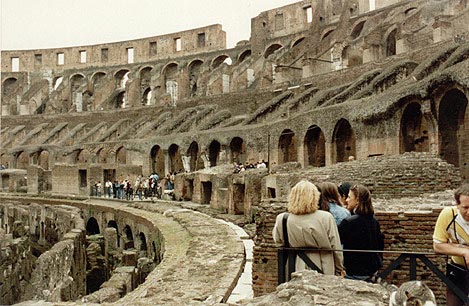 |
|
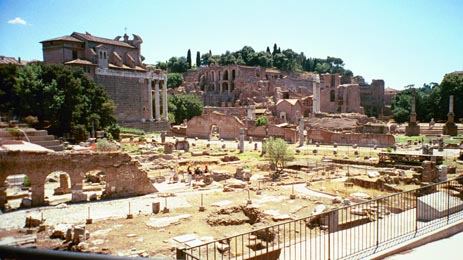 |
| We tried to enter the forum at
the entry point described in JT, but failed. This
is an over arching view of the forum taken near
the road. |
|
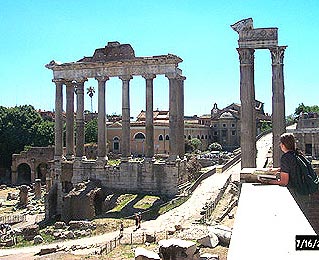 |
| What's left of the Temples of
Saturn and Concord. |
|
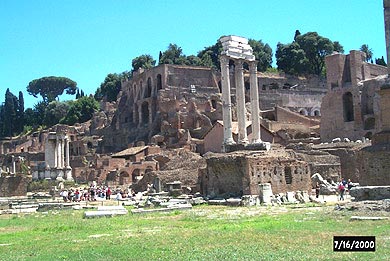 |
| What remains of the Temple of
the Deified Caesar, built in 31 B.C. The three
column is what's left of the Temple of the
Castores. |
|
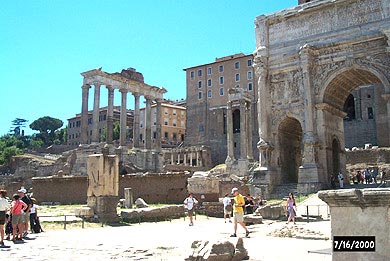 |
| The Arch of Septimius Severus on
the right. The low platform on its right is the
Rostra where orators would preach. This is the
origin of our word "Rostrum". |
|
 |
| The left and |
|
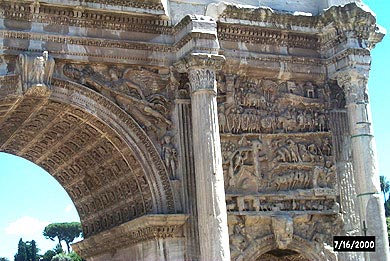 |
| right detail on the arch. |
|
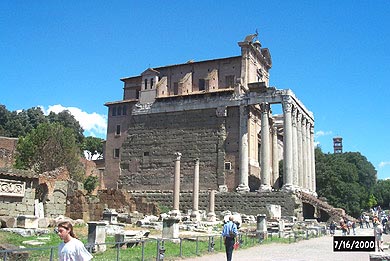 |
| This is Via Sacra, or Sacred
Way. |
|
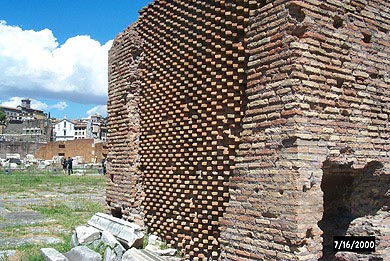 |
| A very interesting brickwork,
eroded over the years. |
|
|
|
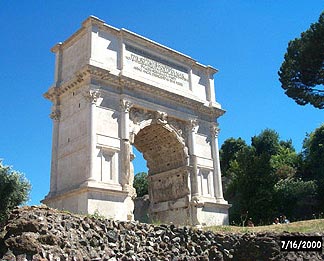 |
| The Arch of Titus, which was
built to commemorate the defeat of Jerusalem in
70 A.D. |
|
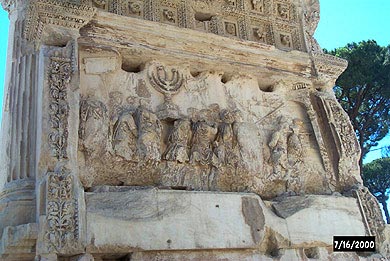 |
| Detail of Arch of Titus showing
the spoils of Jerusalem. |
|
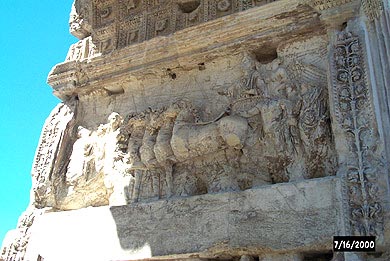 |
| Detail on the other panel. |
|
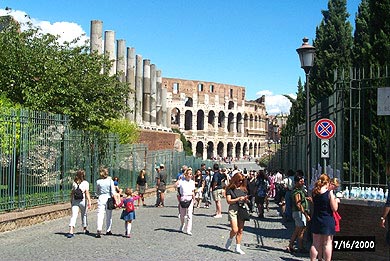 |
| Exiting the Roman Forum walking
back to the colessiem. |
|
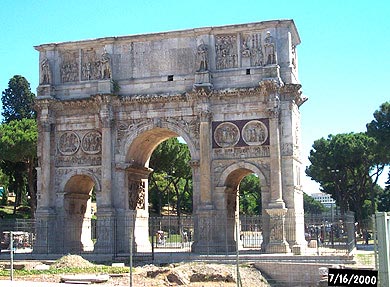 |
| Arch of
Constantine |
|
|
|
| And so, we finish Sunday, DAY
ONE of our extension. That picture on the left is
one Judy Testa probably never saw. It is the
sparkling new addition to the train, Bus and
Metro station and was done just for Jubilee 2000.
We have some other pictures of the lower level
which is a gigantic mall. We have the pictures
despite a security guard telling us that taking
pictures in the station is not allowed. Now, I
can understand places like St. Peter's, but a
Train Station? Come ON! |
| |
|